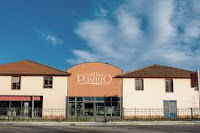Carla Capalbo was the moving spirit behind this excellent event devoted to re-establishing the reputation of one of our favourite wines: Lambrusco.
Carla had kindly invited us to two similarly lavish tastings previously: Collio at the Savile Club and Pignoletto at 67 Pall Mall. We were no less privileged to have attended 'Lambrusco Goes Large in London' in November last year.
The InterContinental Hotel, Park Lane was the handsome venue for this 100-wine survey of the many Lambrusco styles and varieties. Although limited to the members of the Consorzio Tutela Lambrusco DOC it is difficult to imagine a better range of wines designed to re-habilitate the reputation of this unjustly maligned family of grapes.
As ever, Ian D'Agata puts the case for this wine persuasively;
'...there are thrilling Lambrusco wines to be had...and not just lip-smacking delicious dry Lambruscos rosso and rosato, but great sweet ones too. Wine snobs will sneer at the latter wines, but I don't see the poblem: if some fetishists prize fruitiness and sweetness in their wines above all else, who am I to argue? And besides, I like those wines too.'
Three long tables were arranged in a horseshoe with Lambrusco Sorbara on the first, Mainly Grasparossa on the second and 'gli altri' on the third.
The very first wine was a white Lambrusco from Lambrusco Sorbara. Sorry to say this was not the best introduction as far as we were concerned. Some years ago we had paid £5 for a Lambrusco tasting at a London winemerchants (now defunct) and were offered only white Lambruschi without any explanation. |
| or the man who asked for a red Lambrusco at the white Lambrusco tasting |
Puianello's 'Rosa Matilde' is made exclusively from Lambrusco Montericco. It was one of our favourites and received 17 points from Julia Harding for Purple Pages. Abv 11%.
Montericco 100%. Abv 11%.
Primarosa: Salamino (30%), Marani (30%), Maestri (30%) and Ancelotta (10%). Abv 11%.
Quite a selection from one Cantina.
Other interesting wines included Medici Ermete's 'Unique' made exclusively from the increasingly rare Lambrusco Marani. D'Agata characterises Marani as refined and not too tannic but it has lost much ground to Lambrusco Maestri which is fruitier and richer.
Venturini Baldini's Rubino del Cerro was an interesting one. Said to be Michael Schumacher's favourite, it is made from Grasparossa, Salamino and Montericco and weighs in at Abv 11.5%.
Lombardini 'Il Campanone.' Salamino (80%) and Sorbara (20%). (11.5%)
Some statistics: of the 100 wines in the show. the following numbers of Lambrusco varieties were made in purezza
Sorbara 28
Grasparossa 34
Salamino 4
Maestri 1
Montericco 2
Marani 1
Blends of from 2 - 4 of the above varieties accounted for 27 wines.
There were also some blends described as "Lambrusco varieties from Modena Province." We would like to have known which these were. the excellent booklet covering the show mentions the following as constuting the Ampelorapuic Base for Modena:
Lambrusco Grasparossa
Lambrusco Salamino
Lambrusco di Sorbara
Lambrusco Marani
Lambrusco Maestri
Lambrusco Montericco
Lambrusco Oliva
Lambrusco a foglia frastegiata
and Ancelotta, Malbo Gentile and Fortana to a maximum of 15%
and for what it is worth, Ian D'Agata mentions Modena in connection with the following Lambruschi
Lambrusco di Salamino
Lambrusco di Foiano
Lambrusco Montericco
Lambrusco Benetti
The mention of Lambrusco a foglia frastegiata surprising as it is genetically different from any Lambrusco and is now called Enantio. It is not even grown in Emilia Romana.
Some facts and factoids:
*The Lambruscos may be the oldest family of [Italian] native grape varieties (D'Agata).
*Lambruscos have nothing to do with Vitis Labrusca.
*In the 17th century there were thought to be as many as 50 varieties of Lambrusco reduced to 23 in 1906 and then to 10 in 1962. Today the number is said to be 8.
*Lambrusco varieties are mainly grown in Emilia Romagna but are also found in Lombardy, Trentino, Veneto, Puglia, Argentina, and Australia.
*Ancelotta makes some appearances in Lambrusco blends which is hardly surprising as it represents 50% of the grapes grown aroud Reggio-Emilia and thanks to its teinturier qualities is permitted in no less than 42 IGT areas.
*In 'Native Wine Grapes of Italy' published in 2014 there is no mention of a white Lambrusco. Only Red and Rosato. In 'Wine Grapes' there is only oblique references to Lambrusco Montericco being authorised in the blend of white Reggiano Spumante and Lambrusco Marani which 'may comprise up to 100% of Reggiano Bianco Spumante.'
*Lambrusco is made by 17 co-ops, 53 wineries and 5,000 growers
*There are10,000 ha of Lambrusco vines and an average annual production of 35 million bottles of DOC Lambrusco plus 100 million bottles of IGT Lambrusco, 60% of which is exported.

































No comments:
Post a Comment